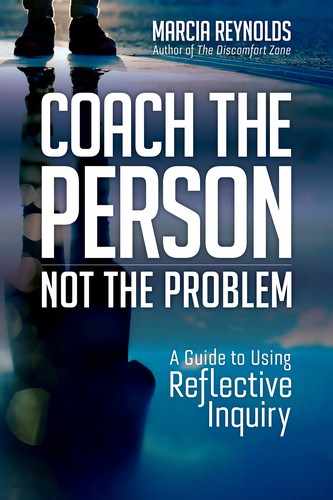PART III
THE THREE MENTAL HABITS
Mastery is the deepening of presence, not the perfection of skills.
—MARCIA REYNOLDS
WHEN I TEACH leaders how to use a coaching approach to their conversations, I often hear the complaint “I’m asking more questions. No matter what I do, they don’t open up to me.”
My answer is always, “How are you listening?”
Knowing what to say in a coaching conversation is not enough. Developing coaching skills will help you engage clients to sort out their thoughts and think more clearly for themselves. Going deeper—uncovering what clients really want and what is stopping them from achieving their desires—requires that clients feel safe with you.
Leadership expert Doug Silsbee said, “In fact, our ability to facilitate lasting, sustainable development in others absolutely rests on the presence that we offer to the relationship.”1 In his book Presence-Based Coaching, Silsbee defined the power of the relational field. The energy between two people is often referred to as the atmosphere or vibrations felt. This energy can now be measured.2
Our nervous system acts as a radio receiver. We pick up the emotional waves of the person we are with. Carl Jung said, “The meeting of two personalities is like the contact of two chemical substances.”3 Something happens in the space between brains when people interact. We either connect or disconnect according to how we feel in each other’s presence. We open up or shut down.
This emotional contagion is not equally weighted. The emotions of the socially dominant person in a conversation carry more impact.4 The coach, unless intimidated by the status of the client, is the socially dominant person in a coaching conversation. Even if you are adept at hiding your emotions, clients will be affected by what you are feeling.
Your emotions and your regard for your clients will impact their willingness and courage to learn. Clients need to feel psychologically safe with you.
PSYCHOLOGICAL SAFETY
Our brains are attuned to threats. We sense danger energetically. The coach’s responsibility is to create the conditions for clients to feel safe enough to say what is on their minds. Employee engagement expert William Kahn described psychological safety as “being able to show and employ one’s self without fear of negative consequences of self-image, status or career.”5 Coaches are responsible for creating a safety bubble where clients feel comfortable being themselves.6
Clients may trust what you say. They may trust you will keep the conversation confidential. They trust you but might not feel safe to fully express themselves to you. They might wonder, “Will I be ridiculed or made to feel wrong when I share my thoughts?” or “Will I be laughed at if I reveal my fears and yearnings?” The answer to these questions is no when clients feel you care, you accept their experience and perspective as valid for them, and you believe they are smart and resourceful enough to find a way forward. Your good intentions are lost if you feel fear, impatience, or judgment.
In recent years, researchers have been measuring the value of therapeutic presence where therapy patients, including those who have experienced significant trauma, feel safe enough to fully participate in a difficult conversation. Presence is described as a neurophysiological state of trust and safety in both client and therapist. The need to protect and defend oneself is regulated down, creating optimal conditions for growth and change.7
When practicing therapeutic presence, you don’t need to monitor your posture, nonverbal expressions, and voice. Instead, you open your mind, heart, and gut—the three major organs that make up the nervous system—with curiosity, care, and courage. The emotions you feel have more power to establish safety than the placement of your arms. Additionally, the time you spend thinking about opening your arms, positioning your legs, sitting back, looking concerned, or giving eye contact is time you are in your head and not present to the person you are with.
If you open the centers of your nervous system with curiosity, care, and courage and remind yourself of your belief in the other person’s potential, it’s likely your nonverbal behavior will reflect your sincere interest and acceptance whether you cross your arms or not. You need to manage your inner space to ensure the space around you is engaging and comfortable.
The following chapters will help you implement the three mental habits that provide the psychological safety needed to effectively implement the five practices laid out in part II. To coach with mastery, you need to do the following:
- Align your brain.
- Receive (don’t just listen).
- Catch and release judgment.
A story arc is a continuing story line in a book, movie, or television show that is threaded through and unfolds in all chapters and episodes. The ARC of coaching—employing your mental habits—is threaded through all sessions. Practice these three mental habits to masterfully apply your coaching skills.
